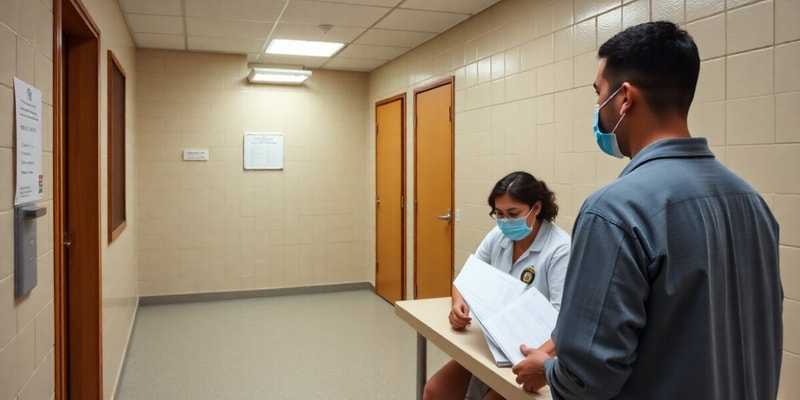Questions and Answers
What is the term used for the admission process in county detention facilities?
Which form of identification is NOT commonly used to verify an inmate's identity during intake?
What term is used for the admission process in state facilities?
Which of the following is a required document for admitting an inmate to a facility?
Signup and view all the answers
What process verifies an inmate's identity when they are moved between correctional facilities?
Signup and view all the answers
Which organization establishes guidelines for detention facilities in Florida?
Signup and view all the answers
What type of documents are included in arrest papers?
Signup and view all the answers
Which of the following actions is NOT a part of the intake/reception process?
Signup and view all the answers
Which of the following is NOT a common feature of arrest papers?
Signup and view all the answers
What document signifies the conclusion of an inmate's sentence as determined by the court?
Signup and view all the answers
Which information is typically included in commitment papers?
Signup and view all the answers
What does 'NTA' refer to in the context of arrest or commitment papers?
Signup and view all the answers
Which feature is associated with arrest papers but NOT with commitment papers?
Signup and view all the answers
What does 'ROR' stand for in arrest terminology?
Signup and view all the answers
Which of the following is a common feature of commitment papers?
Signup and view all the answers
What abbreviation is used to denote 'date of birth' on arrest or commitment papers?
Signup and view all the answers
What is included in confirming the completeness of arrest or commitment papers?
Signup and view all the answers
Who must sign the arrest paperwork?
Signup and view all the answers
Which of the following documents are inmates allowed to keep while in custody?
Signup and view all the answers
What should an inmate do with the documents they are allowed to keep?
Signup and view all the answers
What is required before admitting an unconscious or seriously ill person into a county detention facility?
Signup and view all the answers
What does the intake officer observe to determine if additional medical assessment is needed?
Signup and view all the answers
What happens if an inmate returns to the facility after medical assessment?
Signup and view all the answers
Which of the following is NOT part of the inmate’s reception documents?
Signup and view all the answers
Study Notes
Intake/Reception and Assessment Process
- Understand the intake process in county or state detention facilities is similar to hospital admissions, involving identification and documentation.
- Each facility sets distinct intake and assessment guidelines based on state laws (e.g., Florida Model Jail Standards).
- In county facilities, "intake" is the term used, while in state institutions, it is termed "reception."
Identity Verification
- Identity is verified through multiple forms, including:
- Driver's license, military ID, or valid photo ID
- Fingerprinting
- Verification also occurs during inmate transfers between facilities, to court, or within the facility.
Arrest Papers
- Arrest papers include documents filed by arresting officers, leading to detention facility admission.
- Common features of arrest papers:
- Personal information: name, aliases, date of birth, sex, race, address, phone, Social Security number, height, weight, driver’s license details, place of birth.
- Date, time, and place of arrest.
- Agency case number and detailed charges, including statute numbers.
- Arresting officer and agency details, probable cause affidavit, relevant warrants.
Commitment Papers
- Commitment papers are generated post-conviction and indicate commitment to a facility.
- Common features of commitment papers:
- Judgment and sentence pages signed by a judge.
- Court documents with sentencing and recommendations.
- Criminal history printout from FCIC/NCIC.
- Summary of inmate behavior from the sending agency.
- Medical transfer summary from the sending facility.
Terminology on Arrest/Commitment Papers
- Familiarize with terms and abbreviations:
- NTA: Notice to Appear, a summons for court appearance.
- ROR: Release on Recognizance, pretrial release without monetary bond.
- EOS: End of Sentence, determined by court and may adjust based on good behavior.
- DOB: Date of Birth as per inmate’s ID.
Confirming Completeness of Documents
- Essential to ensure all arrest/commitment paperwork is complete, including:
- All necessary information and documents present.
- Signatures from the arresting officer and inmate on arrest paperwork.
- Signatures from the sentencing judge on commitment papers.
Document Retention for Inmates
- Inmates are allowed to keep certain documents while in custody:
- Court documents and copies of property receipts.
- Legal paperwork relevant to their case, inmate handbook, and copies of arrest papers.
- A copy of the Prison Rape Elimination Act (PREA).
Medical Assessments during Intake
- Unconscious, seriously ill, or injured individuals cannot be admitted without medical clearance per Florida Model Jail Standards.
- Guidelines exist for medical, suicide, and other necessary screenings.
- Intake officers assess inmates for visible injuries and impairment, consulting medical staff for suitability for facility admission.
- Inmates requiring medical attention must receive clearance from a physician upon return.
Studying That Suits You
Use AI to generate personalized quizzes and flashcards to suit your learning preferences.
Related Documents
Description
This quiz covers the intake and assessment process used in county or state detention facilities. It draws parallels to hospital admission procedures, emphasizing the importance of identification and documentation. Test your understanding of how these essential steps ensure proper management and care in these facilities.




